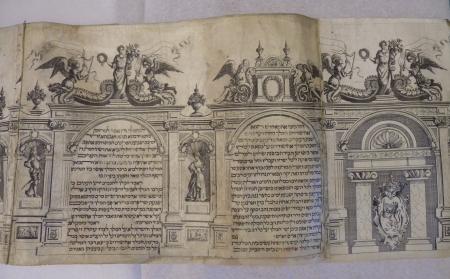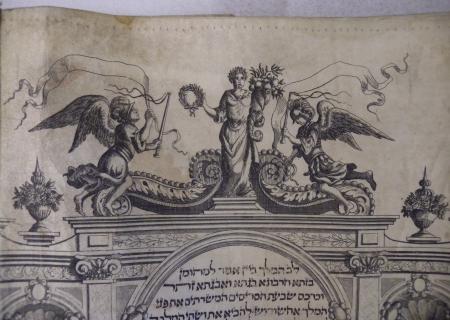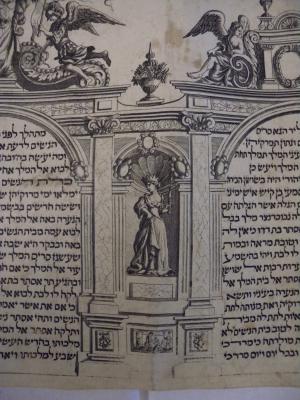Obj. ID: 34765
Hebrew Illuminated Manuscripts MAHJ Engraved Scroll after Shalom Italia, Amsterdam (?), second half of the 17th century

The scroll is adorned with a printed border within which the text of the Megillah is inscribed by a scribe. Its first membrane is trimmed into a semicircle and contains only the opening decoration that shows a structure based on two columns supporting a tympanum; it frames the cartouche with a coat of arms. All other membranes are adorned with an identical decorative scheme printed with the same engraved plate that surrounds three columns of the text (an exception are sheets nos. 2 and 9 which were trimmed and they include two text columns and only a part of the decoration). The upper margin of each membrane is adorned with two compositions. The first of them includes an allegory of Peace standing on a pedestal with a cornucopia in one hand and a wreath in another one. The central female figure is flanked by two winged young men wearing long gowns and helmets who hold waving flags and sticks with ribbons or whips (?). Another composition is formed of two angels seated on either side of a low structure - presumably a tomb - decorated with a wreath and two urns. On the right and on the left, the sheets are decorated with depictions of the allegory of Peace and in the center, a composition with two angels is placed; all three are interspersed by flower-filled vases. The text columns are inscribed within arches supported on marble columns (this suggests the pattern visible on their shafts). Below them, on their bases, fruits (pears?) framed in squares can be seen. Next to the columns, in the niches topped with a Rocaille motif, full figures of the Esther story protagonists are positioned. They are Haman (?), Mordecai, Queen Esther, and King Ahasuerus. Below them, in the small rectangular frames are included four narrative scenes from the Book of Esther but due to their workmanship they are difficult to unequivocally interpret: 1) Hanging of Haman (Es. 7:10); 2) possibly the king who gives his ring to Haman (Es. 3:10) or Mordecai (Es. 8:2); 3) and 4) possibly Esther before the king (related to an unidentified verse). The lower margins of the sheets are blank.
The scroll is mounted on a wooden turned roller.
The style of decoration in the scroll and its layout resembles some engraved scrolls embellished with the borders created by Shalom Italia but it seems unlikely that this decorative scheme was designed by him. Based on the similarity with Italia's scrolls, it is dated to the mid of the 17th century.
At the edges of the first and second membranes, numerous seam marks are visible. This suggests that originally a belt of fabric was placed underneath the opening section of the scroll as it was practiced among the Amsterdam Jewish communities.
In the upper margins of the sheets, on their right and left edges, some printed details - such as parts of angels' feet - are visible.
To the last membrane, a short piece of parchment is sewn that joins the scroll with the roller.
The scroll is displayed on the permanent exhibition of the Museum.
For the scroll sharing the same pattern in the Index see ID 27890.
sub-set tree:
A | Arch
I | Illustration
C | Cornucopia
V | Vase | Vase with flowers
C | Coat of arms
O | Ornamentation: | Cartouche
E | Esther, Book of (following the order of the story) | Esther story protagonists
A | Allegory
C | Columns
A | Angel , (Sandalfon (angel)), (Metatron (angel))
|
The length of the sheets in the scroll: 1) ca. 180 mm, 2) ca. 330 mm, 3) ca. 600 mm, 4) ca. 595 mm, 5) ca. 600 mm, 6) ca. 590 mm, 7) ca. 700 mm, 8) ca. 575 mm, 9) ca. 370 mm.
Dimensions of the selected details in the scroll:
- opening decoration: ca. 155x135 mm;
- decoration with an allegory of Peace: ca. 70x170 mm;
- decoration with two angels: ca. 60x130 mm;
- figures in the niches: ca. 55 mm (height);
- illustrations: 13x22 mm (without frames);
- text panel: 130x90 mm;
- the print: ca. 230 mm (height);
- an average letter: 3 mm (height);
- enlarged letters: ca. 5 mm (height).
The roller: ca. 485 mm.
The Book of Esther in Hebrew
The scroll is formed of 9 sheets containing 22 columns of the text with 19 lines, except for col. 19 with 11 lines divided into two parts.
The text is inscribed in the Hebrew square Sephardi script with tagin, in black ink, on the flesh side of parchment membranes that are thick, stiff, rough, and rather grey. Both sides of the membranes are similar.
The letters ח (Es. 1:6) and ת (Es. 9:29) are highlighted by their size. Other enlarged and diminished letters are included in col. 19.
The letters ז and ע in the final word of the Megillah are decorated.
The length of the lines of the text fits the text panels.
The ruling is invisible.
The membranes are stitched but in an unusual way for megillot. The first and second sheets were glued and then sewn together, whereas in all other cases, a sheet was placed on the subsequent sheet (they are placed flat on each other and not bent as usually) and they were sewn together with double stitching.
None
A short description in French and English together with images of the scroll are available on https://www.mahj.org/en/discover-collections-key-works/esther-scroll-megillat-ester (accessed on 25.08.2020).















